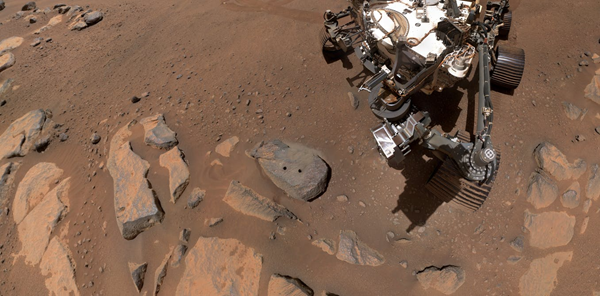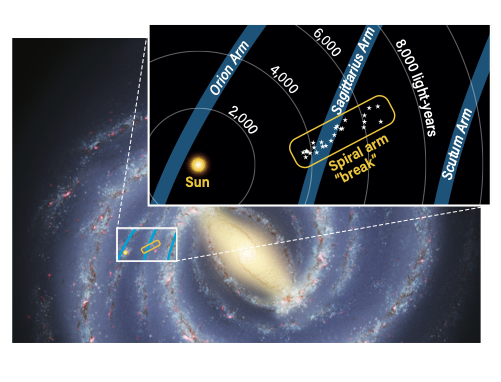News
Hubble Finds Evidence of Persistent Water Vapor in One Hemisphere of Europa
Monday, October 18th 2021 04:21 PM
NASA's Hubble Space Telescope observations of Jupiter's icy moon Europa have revealed the presence of persistent water vapor – but, mysteriously, only in one hemisphere.
Europa harbors a vast ocean underneath its icy surface, which might offer conditions hospitable for life. This result advances astronomers' understanding of the atmospheric structure of icy moons, and helps lay the groundwork for planned science missions to the Jovian system to, in part, explore whether an environment half-a-billion miles from the Sun could support life.
This photograph of the Jovian moon Europa was taken in June 1997 at a range of 776,700 miles by NASA's Galileo spacecraft. Slightly smaller than Earth's moon, Europa has a very smooth surface and the solid ice crust has the appearance of a cracked eggshell. The interior has a global ocean with more water than found on Earth. It could possibly harbor life as we know it. Hubble Space Telescope observations of Europa have revealed the pres...
Read More
Read More
Astronomers get a 3D look at nearby stellar nurseries
Friday, October 15th 2021 04:35 PM
Gas and dust of Perseus molecular cloud, as observed by the NASA´s Spitzer Space Telescope.
About a dozen stellar nurseries reside in the solar neighborhood. Perhaps the most thoroughly studied among them are Taurus and Perseus molecular clouds. Countless celestial cartographers have scrutinized the two regions, filling their maps with stars and vast clouds of gas intertwined with dark, dusty lanes.
But such maps, however beautiful and informative, lacked a crucial piece of the puzzle: the third dimension, distance. Without knowing the distances to these star-forming molecular clouds, astronomers could not unravel their true shape in space — until now.
In a new study published September 2 in The Astrophysical Journal Letters, astronomers explored a recently created 3D dust map of our solar neighborhood. Using it, they discovered that the Taurus and Perseus star-forming regions are both separate parts of a larger shell of compressed gas. According to the researche...
Read More
Read More
NASA Turns to the Cloud for Help With Next-Generation Earth Missions
Thursday, October 14th 2021 04:14 PM
The state-of-the-art Earth science satellites launching in the near future will be generating unprecedented quantities of data on our planet’s vital signs. Cloud computing will help researchers make the most of those troves of information. Credit: NASA Earth Observatory
As satellites collect larger and larger amounts of data, engineers and researchers are implementing solutions to manage these huge increases.
The cutting-edge Earth science satellites launching in the next couple of years will give more detailed views of our planet than ever before. We’ll be able to track small-scale ocean features like coastal currents that move nutrients vital to marine food webs, monitor how much fresh water flows through lakes and rivers, and spot movement in Earth’s surface of less than half an inch (a centimeter). But these satellites will also produce a deluge of data that has engineers and scientists setting up systems in the cloud capable of processing, storing, and...
Read More
Read More
With First Martian Samples Packed, Perseverance Initiates Remarkable Sample Return Mission
Wednesday, October 13th 2021 04:17 PM
On Sept. 1, NASA’s Perseverance rover unfurled its arm, placed a drill bit at the Martian surface, and drilled about 2 inches, or 6 centimeters, down to extract a rock core. The rover later sealed the rock core in its tube. This historic event marked the first time a spacecraft packed up a rock sample from another planet that could be returned to Earth by future spacecraft.
Mars Sample Return is a multi-mission campaign designed to retrieve the cores Perseverance will collect over the next several years. Currently in the concept design and technology development phase, the campaign is one of the most ambitious endeavors in spaceflight history, involving multiple spacecraft, multiple launches, and dozens of government agencies.
“Returning a sample from Mars has been a priority for the planetary science community since the 1980s, and the potential opportunity to finally realize this goal has unleashed a torrent of creativity,” said Michael Meyer, lead scientist for...
Read More
Read More
How to Ship the World’s Largest Space Telescope 1,500 Miles Across the Ocean
Tuesday, October 12th 2021 04:56 PM
When NASA’s James Webb Space Telescope launches, it will undergo one of the most harrowing deployment processes any spacecraft has ever endured. But before it even gets on top of its ride to space, Webb had to complete a final journey here on Earth: a 1,500-mile (2,400-kilometer) voyage at sea.
Webb was shipped from California on Sept. 26, ultimately passing through the Panama Canal to reach the Port de Pariacabo — located on the Kourou River in French Guiana, on the northeastern coast of South America — on Oct. 12. Webb will now be driven to its launch site, Europe's Spaceport in Kourou, French Guiana, where it will begin two months of operational preparations before its scheduled Dec. 18 launch.
With the largest and most powerful space telescope ever built as cargo, nothing about this trip was normal.
A Custom-Made “Suitcase”
As a one-of-a-kind machine, Webb required a colossal, specially designed “suitcase” known as STTARS, short...
Read More
Read More
Perseverance’s first major successes on Mars — an update from mission scientists
Monday, October 11th 2021 05:04 PM
Perseverance took a selfie next to its biggest accomplishment yet – the two small drill holes where the rover took samples of Martian rocks.
In the short time since NASA’s Perseverance rover landed in Mars’ Jezero Crater on Feb. 18, 2021, it’s already made history.
At the moment, Mars and the Earth are on opposite sides of the Sun, and the two planets cannot communicate with each other. After working nonstop for the past 216 Martian days, the science teams are taking the first real break since the mission started.
We are two members of the Perseverance team, and with the rover hunkered down for the 20 days of conjunction, it is the perfect time to step back and reflect on the mission thus far.
Perseverance has tested out all of its engineering capabilities, driven 1.6 miles (2.6 kilometers) over rough terrain and taken tens of thousands of photos with its 19 cameras. Of all of these incredible successes, there are three major milestones that we&rsquo...
Read More
Read More
The Milky Way diagnosed with a broken arm
Thursday, September 30th 2021 04:19 PM
No cast required. A collection of stars and gas clouds jut awkwardly from the Milky Way’s Sagittarius Arm in this artist’s concept. The distance and size of the break is shown in the inset.
Even though we call it home, the Milky Way remains rich with mysteries and surprises. Case in point: Astronomers recently noticed our galaxy has a broken arm.
Stretching about 3,000 light-years long, this splinter of stars and gas juts out from the Sagittarius Arm at a roughly 45° angle. While it’s not unusual to spot sharply-angled spurs (also called feathers) in other spiral galaxies, it’s the first time that astronomers have noticed a defect this stark in our own galaxy’s arms.
From Earth’s position within the Milky Way, it’s difficult for scientists to see the entirety of the galaxy. Astronomers used data obtained by the now-retired NASA Spitzer Space Telescope and by the European Space Agency’s Gaia mapping mission to confirm they w...
Read More
Read More
Hubble Shows Winds in Jupiter's Great Red Spot Are Speeding Up
Tuesday, September 28th 2021 04:28 PM
Like the speed of an advancing race car driver, the winds in the outermost "lane" of Jupiter's Great Red Spot are accelerating – a discovery only made possible by NASA's Hubble Space Telescope, which has monitored the planet for more than a decade.
Researchers analyzing Hubble's regular "storm reports" found that the average wind speed just within the boundaries of the storm, known as a high-speed ring, has increased by up to 8 percent from 2009 to 2020. In contrast, the winds near the red spot’s innermost region are moving significantly more slowly, like someone cruising lazily on a sunny Sunday afternoon.
Researchers found that the average wind speed just within the boundaries of the Great Red Spot, set off by the outer green circle, have increased by up to 8 percent from 2009 to 2020 and exceed 400 miles per hour.
By analyzing images taken by NASA's Hubble Space Telescope from 2009 to 2020, researchers found that the average wind speed just within the boundari...
Read More
Read More
Landsat 9 Is Set for Liftoff
Monday, September 27th 2021 04:38 PM
On Monday, Sept. 27, 2021, at 2:12 EDT a United Launch Alliance Atlas V rocket with the Landsat 9 satellite is slated to lift off on a mission to observe Earth, the planet we call home.
The Landsat 9 satellite is a joint NASA/U.S. Geological Survey mission that will continue 50-year legacy of monitoring Earth’s land and coastal regions.
This image was taken on Sunday, Sept. 26, 2021, at Vandenberg Space Force Base in California.
Image Credit: NASA/Bill Ingalls
Read More
Read More
Hubble Finds Early, Massive Galaxies Running on Empty
Thursday, September 23rd 2021 04:14 PM
When the universe was about 3 billion years old, just 20% of its current age, it experienced the most prolific period of star birth in its history. But when NASA's Hubble Space Telescope and the Atacama Large Millimeter/submillimeter Array (ALMA) in northern Chile gazed toward cosmic objects in this period, they found something odd: six early, massive, "dead" galaxies that had run out of the cold hydrogen gas needed to make stars.
Without more fuel for star formation, these galaxies were literally running on empty. The findings are published in the journal Nature.
These images are composites from NASA's Hubble Space Telescope and the Atacama Large Millimeter/submillimeter Array (ALMA). The boxed and pullout images show two of the six, distant, massive galaxies where scientists found star formation has ceased due to the depletion of a fuel source – cold hydrogen gas. Hubble, together with ALMA, found these odd galaxies when they combined forces with the "natural lens" in...
Read More
Read More









